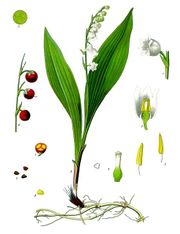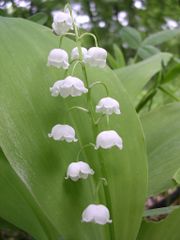Lily of the Valley
| Convallaria majalis | |
|---|---|
 |
|
| Convallaria majalis | |
| Scientific classification | |
| Kingdom: | Plantae |
| (unranked): | Angiosperms |
| (unranked): | Monocots |
| Order: | Asparagales |
| Family: | Ruscaceae |
| Genus: | Convallaria |
| Species: | C. majalis |
| Binomial name | |
| Convallaria majalis L. |
|
Convallaria majalis (pronounced /ˌkɒnvəˈlɛəriə məˈdʒeɪlɨs/),[1] commonly known as the lily of the valley or lily-of-the-valley, is possibly the only species in the genus Convallaria in the flowering plant family Ruscaceae (or one of two, or three, if C. keiskei and C. transcaucasica are recognised as separate species). It was formerly placed in the lily family Liliaceae, or in its own family called Convallariaceae. This woodland plant is native throughout the cool temperate Northern Hemisphere in Asia and Europe and a limited native population in Eastern USA [2] (Convallaria majalis var. montana). There is, however, some debate as to the native status of the American variety.[3]
Contents |
Description

C. majalis is a herbaceous perennial plant that forms extensive colonies by spreading underground stems called rhizomes. New upright shoots are formed at the ends of stolons in summer,[4] these upright dormant stems are often called pips.[5] These grow in the spring into new leafy shoots that still remain connected to the other shoots under ground, often forming extensive colonies. The stems grow to 15–30 cm tall, with one or two leaves 10–25 cm long, flowering stems have two leaves and a raceme of 5–15 flowers on the stem apex. The flowers are white tepals (rarely pink), bell-shaped, 5–10 mm diameter, and sweetly scented; flowering is in late spring, in mild winters in the Northern Hemisphere it is in early March. The fruit is a small orange-red berry 5–7 mm diameter that contains a few large whitish to brownish colored seeds that dry to a clear translucent round bead 1–3 mm wide. Plants are self-sterile, and colonies consisting of a single clone do not set seed.[6]
Taxonomy
There are three varieties that have sometimes been separated out as distinct species or subspecies by some botanists.[7]
- C. majalis var. rosea, with pink flowers, is also recognised by many authorities.[8]
Convallaria transcaucasica is recognised as a distinct species by some authorities, while the species formerly called Convallaria japonica is now classified as Ophiopogon japonicus.[8]
Garden use

Convallaria majalis is a popular garden plant, grown for its scented flowers and for its ground-covering abilities in shady locations. Some consider it a weed, as it can spread over a wide area in gardens and can be difficult to contain or remove.
Various kinds and cultivars are grown, including those with double flowers, rose-colored flowers, variegated foliage and ones that grow larger than the typical species.[8]
- C. majalis 'Albostriata' has white-striped leaves
- C. majalis 'Green Tapestry', 'Haldon Grange', 'Hardwick Hall', 'Hofheim', 'Marcel', 'Variegata' and 'Vic Pawlowski's Gold' are other variegated cultivars[8]
- C. majalis 'Berlin Giant' and C. majalis 'Géant de Fortin' (syn. 'Fortin's Giant') are larger-growing cultivars[8]
- C. majalis 'Flore Pleno' has double flowers.[8]
Foodplant for insect larvae
Lily of the valley is used as a food plant by the larvae of some Lepidoptera species including the Grey Chi.
Legend and tradition
Christian legend

The flower is also known as Our Lady's tears, since, according to Christian legend, the lily of the valley came into being from Eve's tears after she was driven with Adam from the Garden of Eden,[9] although this seems unlikely, since in Catholic parlance, "Our Lady" refers to the Virgin Mary. Another Christian legend states that Mary's tears turned to lily of the valley when she cried at the crucifixion of Jesus, and because of this it is also known as Mary's tears. According to another legend, lilies of the valley also sprang from the blood of Saint Leonard of Noblac during his battles with a dragon.
The name "lily of the valley" is also used in some English translations of the Bible in Song of Songs 2:1, although whether or not the Hebrew word "shoshana" (usually denoting a rose) originally used there refers to this species is uncertain.
It is a symbol of humility in religious painting. Lily of the valley is considered the sign of Christ's second coming. The power of men to envision a better world was also attributed to the lily of the valley.
Other names and legends
Other names include May lily, May bells, lily constancy, ladder-to-heaven, male lily and muguet (French). Its scientific name, majalis or maialis, means "of or belonging to May", and old astrological books place the plant under the dominion of Mercury, since Maia (mythology)"Maia, the daughter of Atlas, was the mother of Mercury or Hermes.
In the "language of flowers", the lily of the valley signifies the return of happiness. Legend tells of the affection of a lily of the valley for a nightingale that did not come back to the woods until the flower bloomed in May.
Symbolic uses
Traditionally, lily of the valley is sold in the streets of France on May 1. Lily of the valley became the national flower of Finland in 1967. The Norwegian municipality Lunner has a lily of the valley in its coat-of-arms. It is the official flower of Alpha Delta Phi fraternity, Pi Kappa Alpha fraternity, Kappa Sigma fraternity, Delta Omicron fraternity, Alpha Epsilon Phi sorority, and Alpha Phi sorority. It is also the official flower of Job's Daughters International.
Traditional herbal medicine
Lily of the valley has been used for medicinal purposes. It is believed to strengthen memory, to restore speech and as a liquor smeared on the forehead and the back of the neck, to make one have good common sense. All parts of the plant are considered poisonous, despite its alleged powers. The leaves yield a green dye, with lime water.[10]
Toxicity
All parts, including the berries, of the lily of the valley are highly poisonous. [11][12] Roughly 38 different cardiac glycosides (cardenolides) have been found in the plant, some among others:
- convallarin
- convallamarin
- convallatoxin
- convallotoxoloside
- convallosid
- neoconvalloside
- glucoconvalloside
- majaloside
- convallatoxon
- corglycon
- cannogenol-3-O-α-L-rhamnoside
- cannogenol-3-O-β-D-allomethyloside
- cannogenol-3-O-6-deoxy-β-D-allosido-β-D-glucoside,
- cannogenol-3-O-6-deoxy-β-D-allosido-α-L-rhamnoside,
- strophanthidin-3-O-6-deoxy-β-D-allosido-α-L-rhamnoside,
- strophanthidin-3-O-6-deoxy-β-D-allosido-α-L-arabinoside,
- strophanthidin-3-O-α-L-rhamnosido-2-β-D-glucoside,
- sarmentogenin-3-O-6-deoxy-β-D-allosido-α-L-rhamnoside
- sarmentogenin-3-O-6-deoxy-β-D-guloside
- 19-hydroxy-sarmentogenin-3-O-α-L-rhamnoside,
- 19-hydroxy-sarmentogenin
- arabinosido-6-deoxyallose
- lokundjoside
The plant also contains saponins. Although deadly, the plant has been used as a folk remedy in moderate amounts[13], and is currently used by herbalists as a restricted herbal remedy. If the plant is touched or handled, hands should be washed before doing anything else.
References
- ↑ Sunset Western Garden Book, 1995:606–607
- ↑ Flora of North America : Convallaria majalis
- ↑ Gleason, Henry A. and Cronquist, Arthur, (1991), Manual of Vascular Plants of Northeastern United States and Adjacent Canada, New York Botanical Garden, Bronx, New York, pp. 839-40
- ↑ Flora of China: Convallaria majalis
- ↑ Mills, Linn; Post, Dick (2005), Nevada gardener's guide, Nashville, Tenn.: Cool Springs Press, pp. 137, ISBN 1591861160, http://books.google.com/books?id=oSjvc0zI1EsC&pg=PA137&dq=pips+lily+of+the+valley&ei=oBaFSfv5G5WyyQSslLSoDQ&client=firefox-a
- ↑ 6.0 6.1 Ohara, Masashi; Araki, Kiwakoi; Yamada, Etsukoi; Kawano, Shoichi, Life-history monographs of Japanese plants, 6: Convallaria keiskei Miq. (Convallariaceae), Plant Species Biology, Vol 21, No 2, August 2006, pp. 119–126(8), Blackwell Publishing
- ↑ http://www.efloras.org/florataxon.aspx?flora_id=1&taxon_id=107908
- ↑ 8.0 8.1 8.2 8.3 8.4 8.5 8.6 RHS Plant Finder 2009–2010. Dorling Kindersley. 2009. pp. 195, 196. ISBN 978-1-4053-4176-9.
- ↑ http://www.birthflowersguide.com/may-birth-flower.html
- ↑ http://www.angelfire.com/journal2/flowers/l.html
- ↑ http://health.nytimes.com/health/guides/poison/lily-of-the-valley/overview.html
- ↑ http://museum.gov.ns.ca/poison/?section=species&id=79
- ↑ Cantell, Sulo; Saarnio, Väinö, 1936. Suomen myrkylliset ja lääkekasvit (translation: The Poisonous and Medical plants of Finland, no known translated literature available)